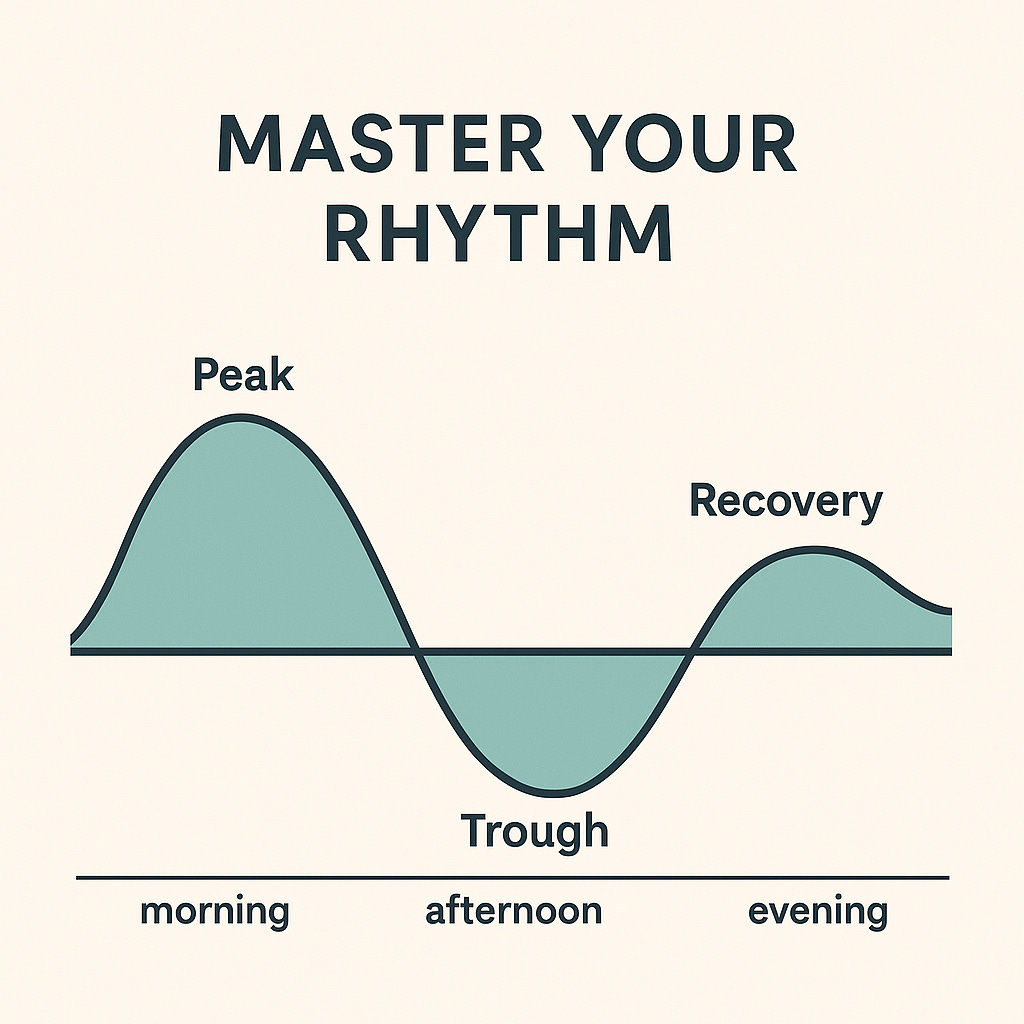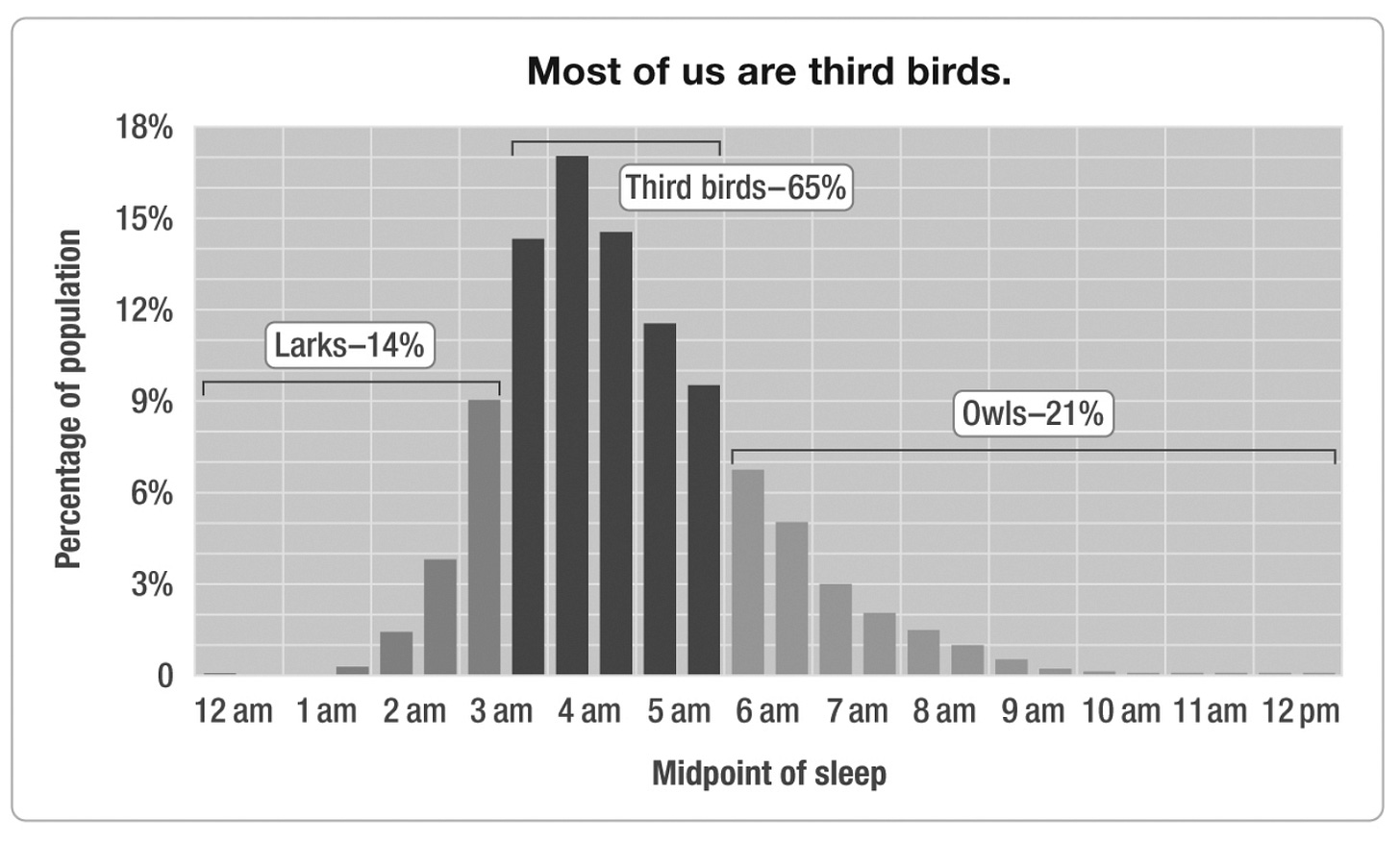Why "Midday Slump" is Not Your Fault (And How to Hack It)
Learn the science-backed timing sequence that can improve your cognition, health, and happiness—just by working with your biology.
I’m Brandon Wilson. I’m on a mission to be wellthy — healthy, without giving up the joy of living. I explore ancient wisdom, modern biohacks, and real-life wellness experiments so you don’t have to.
Every Monday, I share simple, sustainable ways to upgrade your mind, body, and spirit — without living like a monk.
👉 Join the Be Wellthy Club ($7/month or $70/year) to get full access to 260+ past issues, bonus content, exclusive audio, and member-only insights.
First time reading? Welcome. Let’s help future you feel proud of your choices.
In today’s newsletter:
A daily pattern that affects your physical and mental performance
A simple assessment to determine your chronotype
🎮 Cheat Code: A biohack to avoid the afternoon slump
A daily habit that recommends the best times for specific tasks based on your chronotype
Have you ever said to yourself, “This is just not the right timing?” Maybe you were deliberating a big decision, attempting a creative task, struggling to hop into a cold plunge or step into a sauna, or trying to answer the most challenging question of the day, “What’s for dinner?” We tend to focus on the what or the how of doing something, but just as important (if not more so) is when we do it. I’ve been reading the book "When: The Scientific Secrets of Perfect Timing" by Daniel H. Pink, and I'd like to share some very useful information about how to time your day for better results.
In the book, Daniel cites a fascinating 2016 study that revealed a consistent pattern. Researchers from Cornell University analyzed the words of more than 500 million tweets from 2.4 million users across 84 countries over a two-year period. When assessing the positive tone of people’s tweets, they found a rise in mood in the morning, a dip in the afternoon, and a rise again in the evening.
This pattern has shown up repeatedly in research. In general, for most of us, our moods and mental performance fluctuate throughout the day, with peaks in the morning, lows in the afternoon, and a rebound in the evening. I say most because your chronotype, a personal pattern of circadian rhythms that influences physiology and psychology, affects this pattern.
You may have referred to people as early birds (larks) or night owls. Some people are morning people, and others get their mojo in the evening. Most people fall into a hybrid category that Daniel calls “third birds.”
Assessing Your Chronotype
A simple way to assess your chronotype is to answer three questions. Think about your behavior during “free days” when you are not required to wake up at a specific time.
What time do you usually go to sleep?
What time do you usually wake up?
What is the midpoint between these two times? For example, if you fall asleep at 11:30 p.m. and wake up at 7:30 a.m., your midpoint is 3:30 a.m.
Now find your position on the following chart.
Genetics and age play significant roles in determining your chronotype. Young children are generally larks. High school- and college-aged people are disproportionately owls. Men tend to be owls, and women tend toward larks up until about age 50. People over 60 tend to be early risers even more than when they were children.
Research shows we all experience the day in three stages—a peak, a trough, and a rebound. Larks and third birds experience the day in that order, but owls exhibit behavior closer to the reverse order—recovery, trough, peak. There are implications for brain performance for both analytical and creative tasks. Refer to the Daily Habit for specific recommendations based on your chronotype. Let’s examine how the daily rhythm impacts physical performance through exercise timing.
When to Exercise
The best timing for exercise depends on your goals.
Exercise in the morning to:
Lose weight - Exercising in a fasted state in the morning will use stored fat for fuel. Morning exercise may burn 20 percent more fat than later, post-food workouts.
Boost mood - Cardio workouts help elevate mood. If you do cardio in the morning, you experience the benefits for the rest of the day.
Keep to your routine - Some studies suggest you are more likely to stick to a workout routine when you do it in the morning.
Build strength - Testosterone peaks in the morning, so resistance training in the morning can help build muscle more effectively.
Exercise in the late afternoon or evening to:
Avoid injury - Our body temperature is low when we first wake up and peaks in the late afternoon and early evening. When our muscles are warm, they’re more elastic and less prone to injury. Late afternoon/early evening is also an excellent time for a sauna.
Perform at your best - Lung function is highest in the afternoons, allowing your circulation system to distribute more oxygen and nutrients. This is also when strength peaks, reaction time quickens, hand-eye coordination sharpens, and heart rate and blood pressure drop. One study found a disproportionate number of Olympic records are set in the late afternoon and early evening.
Enjoy the workout more - Research suggests that people typically perceive that they’re exerting themselves less in the afternoon, even if they’re doing the exact same exercise routine as in the morning.
🎮 Cheat Code: Strategic Napping
I used to say if you’re napping, you’re doing it wrong. Obviously, if you’re regularly getting inadequate sleep and replacing it with naps, that’s not optimum. I changed my tune when I learned about research showing that naps can lead to improved cognitive performance and boost mental and physical health. One NASA study found pilots who napped for up to 40 minutes showed a 34 percent improvement in reaction time and a twofold increase in alertness. A review study found that napping has considerable benefits for mood, alertness, and cognitive performance.
My biggest issue with naps is waking up feeling groggy (known as sleep inertia), which can potentially lead to trouble falling asleep that night. The key is timing, and naps of 20 minutes or less don’t produce sleep inertia. Club Members get the 5-Step Plan for a Perfect Nap, which includes a strategic use of caffeine.
The Daily Habit is where I share my habits related to the fundamentals: sleep, diet, physical activity, mindfulness, and stress management.
Determine your chronotype using the method above, or Club Members can use additional free assessments. Use the chart below to determine the optimal timing for you, based on your chronotype.
Be Wellthy Club Member exclusives for this newsletter:
Audio commentary
Links to tools to determine your specific chronotype
5-Step Protocol for a caffeine nap to combat the daily afternoon slump
Three book recommendations and links to obtain them
Keep reading with a 7-day free trial
Subscribe to Be Wellthy to keep reading this post and get 7 days of free access to the full post archives.






